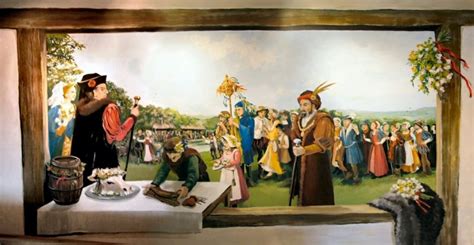The Shaftesbury Byzant
By John Welford
@indexer (4852)
Leicester, England
October 4, 2018 3:48am CST
If you pay a visit to the Museum in the Dorset town of Shaftesbury you are quite likely to see a very strange exhibit that looks a bit like a cross between an open umbrella and a May garland. It is a metal structure that has been gilded to make it look like solid gold, although that is not the case. This is the Shaftesbury Byzant (which is a corruption of “besom”, a type of sweeping brush). It has a fascinating history.
Shaftesbury is a hill town – the only one of its kind in Dorset – that was founded by King Alfred in the year 880. It stands on a sandstone ridge several hundred feet above Blackmore Vale, which stretches away to the north.
Although this was an excellent site for a settlement in terms of its defence, there was always a problem when it came to water supply. In the early days it was easy enough for the population to rely on rainwater collected in cisterns, but as the town got bigger, and thousands of pilgrims visited the Abbey to view the tomb of the martyred boy-king Edward, this was insufficient, and no well could be dug deep enough to reach an adequate supply.
The people of Shaftesbury had no choice but to go down the hill and take water from springs at Enmore Green. Although this is quite close to Shaftesbury, it was traditionally part of the parish of Gillingham, a small town four miles to the northwest.
There was never any real objection to Shaftesbury people helping themselves to Gillingham’s water, but it was thought that some acknowledgment of the fact should be made, and that is where the Byzant comes in.
From the early 16th century it became the custom, on the Sunday after Holy Roode day in May, for the entire population of Shaftesbury, led by the Mayor and Burgesses, to walk in procession down the hill to arrive at Enmore Green at 1pm. An hour of dancing was followed by a ceremony in which the Mayor of Shaftesbury and the Lord of the Manor of Gillingham would engage in a formal ceremony.
At the heart of the ceremony was the Byzant, which had been made by a local craftsman and was usually adorned with precious stones and other treasures donated by the town’s wealthier citizens. This was then offered to the Lord of the Manor of Gillingham as payment for the water, and was duly handed over.
However, the Byzant was such a precious artefact – not to mention the attached jewels – that the Mayor of Shaftesbury immediately sought to buy it back. This he did by making gifts to his opposite number of a pair of white gloves, a calf’s head, two loaves, and a gallon of ale. The people of Gillingham then entertained the citizens of Shaftesbury to a further hour of dancing before the latter departed back up the hill, with the Byzant, and carried on with the merrymaking for the rest of the day.
This ceremony was observed for about 400 years but ended in 1830 at a time of agricultural depression when it was felt that the expense of the occasion could not be justified.
However, the Byzant was retained in Gillingham at this juncture and did not return to Shaftesbury until 1924 when it was presented to Shaftesbury Town Council by the daughter of the 2nd Marquess of Westminster – whose father, as Lord of the Manor of Gillingham, had kept the Byzant back in 1830.
There would now seem little doubt that the Byzant will not leave Shaftesbury again, which these days has no fears about its water running dry!
(The photo was taken from a copyright-free source)
6 people like this
5 responses
@crossbones27 (51796)
• Mojave, California
4 Oct 18
Yay, get to get you back. Wonder what this means? Dammit, does not work, made it to long. Explained it to well. What ever happened to the mystery? 

@crossbones27 (51796)
• Mojave, California
4 Oct 18
@indexer Well that is a long explanation, but you know like poets leave things for self interpretation so people can draw their own conclusions or some say a mystery. 

@crossbones27 (51796)
• Mojave, California
4 Oct 18
@indexer I am just giving you a hard time neat post very well done but remember still need to have fun. All I was doing. Hope did not make you upset in some way.
1 person likes this

@JohnRoberts (109842)
• Los Angeles, California
4 Oct 18
Each town and village in Britain seems to have interesting and extraordinary history.
@asfarasiknow (3340)
• Bournemouth, England
4 Oct 18
I have spent many hours in Shaftesbury and Gillingham but had never heard of this. Fascinating!
@JudyEv (367425)
• Rockingham, Australia
4 Oct 18
I love these stories from ancient days. I find them very interesting. Thanks for sharing them with us.
@JadePlatypus (234)
• Australia
4 Oct 18
How does the town get its water supply now? I suppose a pipeline or something. Interesting piece of history, thank you.
@indexer (4852)
• Leicester, England
4 Oct 18
It would not surprise me if pumping was needed to get water to a high enough point - probably to a water tower that ensures sufficient pressure when it reaches peoples` homes.










